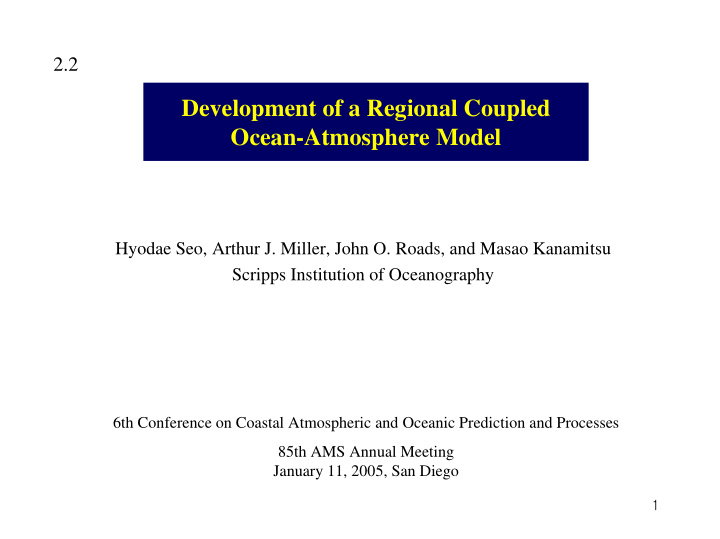



2.2 Development of a Regional Coupled Ocean-Atmosphere Model Hyodae Seo, Arthur J. Miller, John O. Roads, and Masao Kanamitsu Scripps Institution of Oceanography 6th Conference on Coastal Atmospheric and Oceanic Prediction and Processes 85th AMS Annual Meeting January 11, 2005, San Diego 1
Introduction Development of a coupled model system to study air-sea interaction processes to improve ocean-atmosphere prediction TODAY (Preliminary Results): What are some effects of evolving SST on the coupled model fluxes? RESULTS TO BE PRESENTED: SST spatial structures are clearly seen in the flux fields. SST affects shortwave fluxes (cloudiness) in the summer. SST tendency is strongly correlated with latent heat flux anomaly in summer. - Related to observational studies: Ronca and Battisti ( J. Climate ,1997), Chelton et al. ( Science ,2004) 2
Outline 1. Description of Regional Coupled Ocean-Atmosphere Model and Experiments 2. Interaction of the Atmospheric and Oceanic Response - Co-variability of SST anomaly (and its tendency) with components of heat flux anomalies (cf. Ronca and Battisti, 1997) 3. Conclusion and Future Work 3
Regional Coupled Ocean-Atmosphere Model Regional Spectral Regional Ocean net heat flux Model Modeling System freshwater flux (RSM, 20km) (ROMS, 12km) windstress Primitive equation ocean The RSM is nested model within the Global Spectral Model (GSM). Generalized-sigma Winds relative to vertical coordinate currents Physics and dynamics are consistent with the Radiation and flow- NCEP/DOE reanalysis adaptive nudging for model. open boundaries SST Lateral BC: IC and Lateral BC: Levitus T/S Climatology Reanalysis 4
Model Domain and Experiment +2000m Pt. Reyes Northeastern Pacific Sierra-Nevada Pt. Sur Pt. Conception Continental Shelf San Diego -4000m Model Run from 1996 to 2003 with Daily Coupling of Forcings . 5
Interannual Variability of SST Snapshots of Averaged SST of May 10 - 14, 1998-2003 1998 1999 2000 -Upwelling filaments in SST Upwelling Filaments occur north of Pt. Conception CCS -Mesoscale eddies and meanders of the CCS generate strong SST gradients Mesoscale Eddy 2001 2002 2003 � Do these mesoscale SST Pt. Reys features affect the local Pt. Sur atmospheric boundary Pt. Conception layer? 6 SST (°C) 9 20
SST Patterns in Heat Flux and Wind Stress Fields Example: May 10-14, 1999 Net Surface Heat Flux (W/m 2 ) Windstress Curl (N/m 3 ) SURFACE FLUXES SST (°C) 26.4 Isopycnal Depth(m) OCEANIC VARIABLES How do the ocean fields and surface fluxes covary? 7
Net Heat Flux Components for 10-14, May, 1999 Net Heat Flux (W/m 2 ) Shortwave Radiation Longwave Radiation Net Heat Flux = Shortwave + Longwave + Latent + Sensible Latent Heat Sensible Heat SST 8
Covariance of SST tendency with each heat flux in Summer months Normalized Covariance (NC) Summer months (JJASO) of 5 day-averaged 7-year data (monthly mean removed) NC = Local NC of dSST’/dt with latent heating NC of dSST’/dt for 2 regions • • Covariance Normalized • • • • • • shortwave sensible longwave latent Ronca and Battisti: Latent heat flux significantly covaries with windspeed. 9
Covariance of SST and each heat flux in Summer months Normalized Covariance (NC) < > ' ' Q SST lh = NC = i 4 ∑ NC of SST’ for 2 regions < > ' ' 2 1 / 2 [ ( Q SST ) ] i = • i 1 Local NC of SST’ with each component shortwave Covariance Normalized Sensible heat • • • • • • • sensible shortwave longwave latent Negative correlation of SST with cloudiness in summer 10 - (Klein and Hartmann(1993), Norris and Leovy(1994))
Conclusion 1. SST spatial structures are clearly seen in the flux fields. 2. SST tendency is strongly correlated with latent heat flux in summer month (in spite of mesoscale eddy signatures in SST) 3. SST affects solar heating flux through cloudiness in the summer months. 11
Future Work - Future Work Include ocean currents in calculation of coupled model windstress Replace climatological boundary condition with ocean analysis Multi-nesting coupled modeling Thank you! 12
Recommend
More recommend